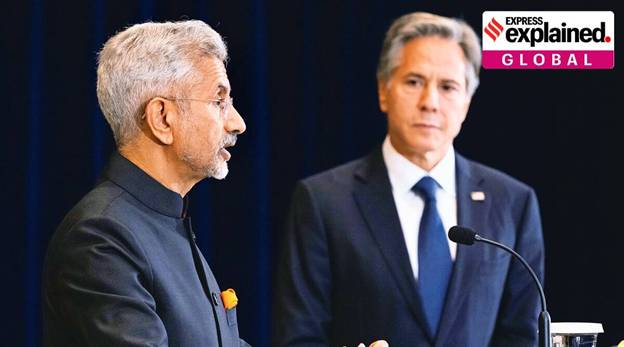INDIA-US TIES: DEPTH & NUANCE

Copyright infringement not intended
Context:
With United States Secretary of State Antony J Blinken by his side, External Affairs Minister S Jaishankar declared, “I am very bullish about the [Indo-US] relationship.” Only the previous day, Jaishankar had remarked that the US decision to provide a $450-million sustenance package for Pakistan’s aging F-16 fleet was “not fooling anybody”.
Details:
- It would appear that Jaishankar had had a change of heart within 24 hours. In fact, such divergences are now routine in the deepening bilateral relationship.
- So with Jaishankar listening, Blinken said it was Washington’s “obligation” to provide military equipment to ensure that Pakistan’s F-16s are kept capable to deal with “clear terrorist threats” from al-Qaeda and the Islamic State.
- As the countries navigate choppy geopolitical waters in the aftermath of the Russian invasion of Ukraine, the relationship is being put through a “stress test”.
Evolution over two decades:
- Following the nuclear tests of May 1998, as much of the western world came down heavily on India, Prime Minister Atal Bihari Vajpayee wrote to President Bill Clinton, putting China in the frame.
- While the tests were a temporary setback, “by the turn of the century, India’s relations with the US and the West, in general, had begun to crystallize into a mutually beneficial and substantive relationship
- The rapprochement and subsequent strengthening of bilateral ties was a major geopolitical shift in the new millennium.
- Talks between then External Affairs Minister Jaswant Singh and US Deputy Secretary of State Strobe Talbott led to President Clinton’s historic visit of March 2000, and the Indo-US nuclear deal of the George W Bush years elevated Indo-US ties to a higher strategic trajectory.
- Obama became the only President to make two visits to India, and he hosted both Prime Ministers Manmohan Singh and Modi in the White House.
- Despite President Donald Trump’s unpredictability, ties continued to improve, the Quad framework was revived, and the defence partnership was strengthened with the signing of the foundational agreements.
- Trump visited India, one of his last visits overseas before the pandemic shut down much of the world.
- Under President Joe Biden, the rhythm has been maintained, especially on the Indo-Pacific strategy — even though the chaotic US exit from Afghanistan last year left New Delhi vulnerable at a time when it was already facing a challenge on the LAC.
Current geopolitical context:
- Russia’s invasion of Ukraine has tested the relationship like never before. India’s refusal to criticise Moscow’s war has made New Delhi’s allies in Europe deeply uncomfortable and caused a fair bit of consternation in Washington and other Western capitals.
- So when Prime Minister Narendra Modi told President Vladimir Putin that “today’s era is not of war”, the US was pleased with the formulation and its articulation in full public glare.
- The US has been unhappy that India has been buying more oil from Russia than earlier. India argues that it must protect its citizens from the inflationary impact of the war.
- While Washington did brief New Delhi on the F-16 programme, framing it as a continuation of the old programme, not a new one, and necessary for Pakistan to fight terrorism, South Block disagreed both on its optics and substance.
- Some analysts in New Delhi view the renewal of the US-Pakistan military engagement as a message to New Delhi for its strategy of “issue-based alignment”.
- Also, while senior US officials such as Under Secretary of State Victoria Nuland and Assistant Secretary Donald Lu have made visits to New Delhi, the absence of a full-time ambassador 20 months after the Biden Administration took charge, has had an impact on ties.
- Even as they navigate the minor turbulence in their relationship due to the Ukraine war, both India and the US see China as the biggest threat and rival.
- With the recent “no-limits” ties between Russia and China, irritants in the US-India relationship present potential weak spots.
- Every leader since Vajpayee has seen the nations as “natural allies” — and there is no better time to accommodate and invest in the relationship.




1.png)
